Neocolonialism: Pillaging the Earth for the ‘Climate’
Native Americans take a stand against “green” extractivism in the Nevada desert.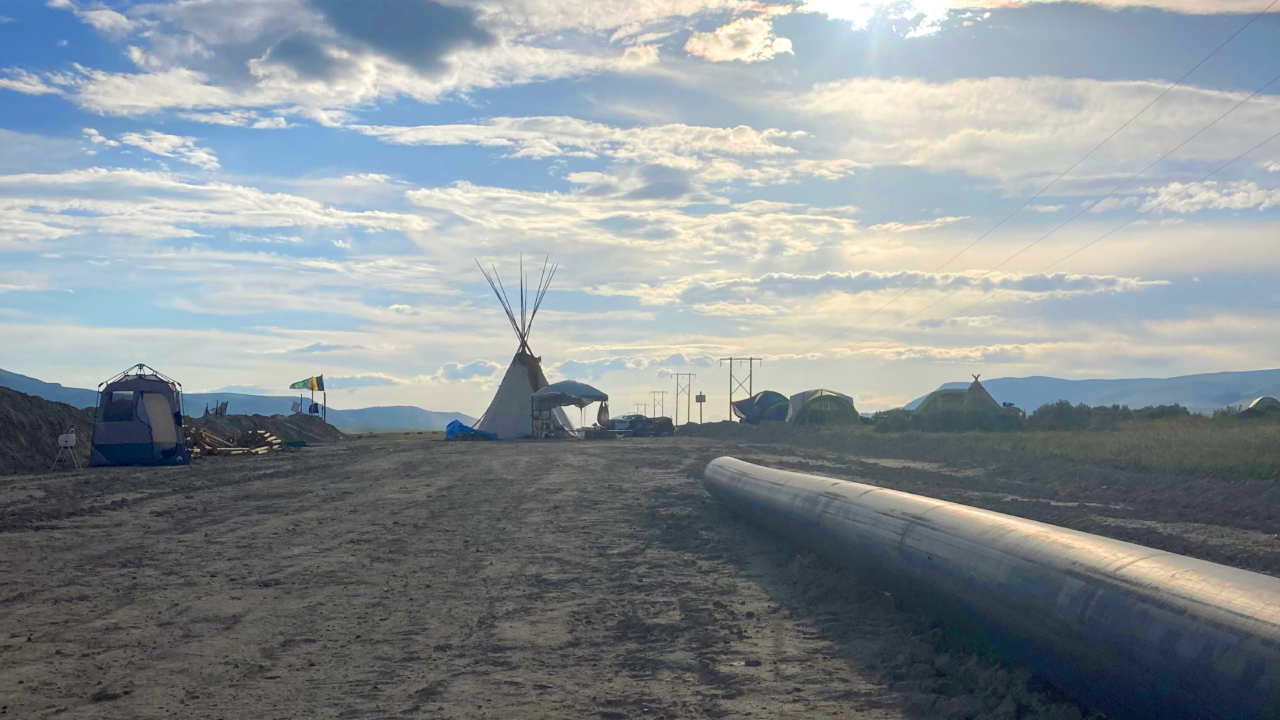 The pipeline takes aim at the camp. (Photo: Christopher Ketcham)
This is Part II of the "Green-Tinted Glasses" Dig series
The pipeline takes aim at the camp. (Photo: Christopher Ketcham)
This is Part II of the "Green-Tinted Glasses" Dig series
On a stormy day in June, a wildlife biologist named Katie Fite stopped to visit the Indigenous Women’s Camp in a remote valley called Thacker Pass, in northwestern Nevada. She had traveled several hours from her home in Idaho and was hoping to meet the leaders of the camp. These were known as the Grandmas. Mostly Paiute and Shoshone women in their 70s and 80s, the Grandmas held vigil at the sacred fire in the central teepee and cooked for the warriors who maintained the camp and guarded it at night. Their goal, shared by the dozen men, women and children who had gathered at their side, was to halt construction of a massive open-pit mine.
Fite arrived to find the camp abandoned, tents empty, flapping in the wind. The sacred fire, kept burning for weeks by the occupiers, had turned to ash. The teepee that contained the firepit lay smashed to the ground, its cedar poles scattered in the dirt.
This is high desert steppe, cold and snowy in winter, sun-scorched in summer, wind-blasted year-round, a place of sparse human settlement, vast open spaces, immense starlit nights, stark mountain ranges, and valleys of dryland rivers that reduce to a trickle after the spring melt. It is part of the sagebrush sea, the name that biologists have given to the stretches of the Great Basin where the sweet-smelling sage dominates plant communities. While it is held in trust for the American people by the U.S. Bureau of Land Management, for the tribespeople of the nearby Fort McDermitt Indian Reservation, it is holy land. In the sagebrush biome at Thacker Pass, the Paiute and Shoshone long practiced ancient lifeways. For unknown centuries, they have hunted mule deer, foraged for foods and medicinal plants, gathered eagle feathers for religious ceremonies, communed with land and sky.
The Indigenous Women’s Camp had gone up in early May and lasted until June 7, when the Humboldt County Sheriff’s Office raided it on behalf of a mining corporation the Indians had come to despise: Lithium Americas, a Canadian entity with $650 million in backing from automobile giant General Motors. The company arrived in Nevada in 2017, claiming to be on the side of conscientious environmentalists as it described its plans to construct a mine that would produce 25% of the world’s known lithium reserves over the next 50 to 100 years. The mine was a good thing. A sign of hope, according to Lithium Americas.
Lithium, of course, is key to a renewable energy build-out for the weaning of industrial civilization off fossil fuels. There’s enough of the stuff in the soil at Thacker Pass to manufacture the batteries for at least 1 million new electric vehicles annually for five decades or more. But lithium is not only pivotal to replacing the internal combustion engine fleet. It is also needed for battery backups in the electrical grid to ensure a steady flow of power given the fatal intermittency of wind and solar. Without lithium, in enormous amounts, there can be no Green New Deal, no decarbonization of the industrial economy.
While the progress-minded executives of Lithium Americas told The New York Times that they were “answering President Biden’s call [to] tackle the climate crisis,” the Grandmas at Thacker Pass held a different view. Mining for the expansion of the electric vehicle fleet and the greening of the energy grid was for them no different than blowing up the valley for a coal mine. They saw the pillage of their sacred site as another iteration of rapacious techno-industrialism, the specialty of the white man’s culture. “This is just the same old program,” one Paiute resister, who requested anonymity, told me. “Neocolonialism. Extract and exploit. But now it’s ‘for’ the climate.”
They saw the pillage of their sacred site as another iteration of rapacious techno-industrialism, the specialty of the white man’s culture.
If the Thacker Pass mine becomes operational, the plant communities there will be devastated, the animals chased out, the air polluted, the aquifers stressed if not sucked dry, which will kill the springs and streams that desert wildlife depend on for survival. The mine will “unleash a thrashing gnashing monster that will destroy everything beautiful and good in this landscape for a century,” Fite, the wildlife biologist, told me. “Folks — including Big Green environmental groups — better wake up,” she wrote on Facebook following her visit in June. “Because this Lithium Boom mining plague that has descended on the West is hard rock mining at its very worst.”
An estimated 80% of lithium in North America sits within 35 miles of Native American reservations, according to Morgan Stanley Capital Investment, a financial research firm that advises the mining industry. So, too, is the case for other minerals pivotal to renewable energy development: 97% of nickel, 89% of copper, 68% of cobalt — all within 35 miles of reservations. Extractive development near Native American communities means jobs, yes, but historically it also has meant pollution, disruption of old lifeways, the killing out of wildlife, and social disorder and trauma. The rape, murder and disappearance of Indian women tends to skyrocket whenever mining, fracking, drilling and similar development occurs near their communities. It’s no surprise that tribes fear what’s coming with green-tech capitalism — because it’s a system wedded as always to corporate profits and economic growth.
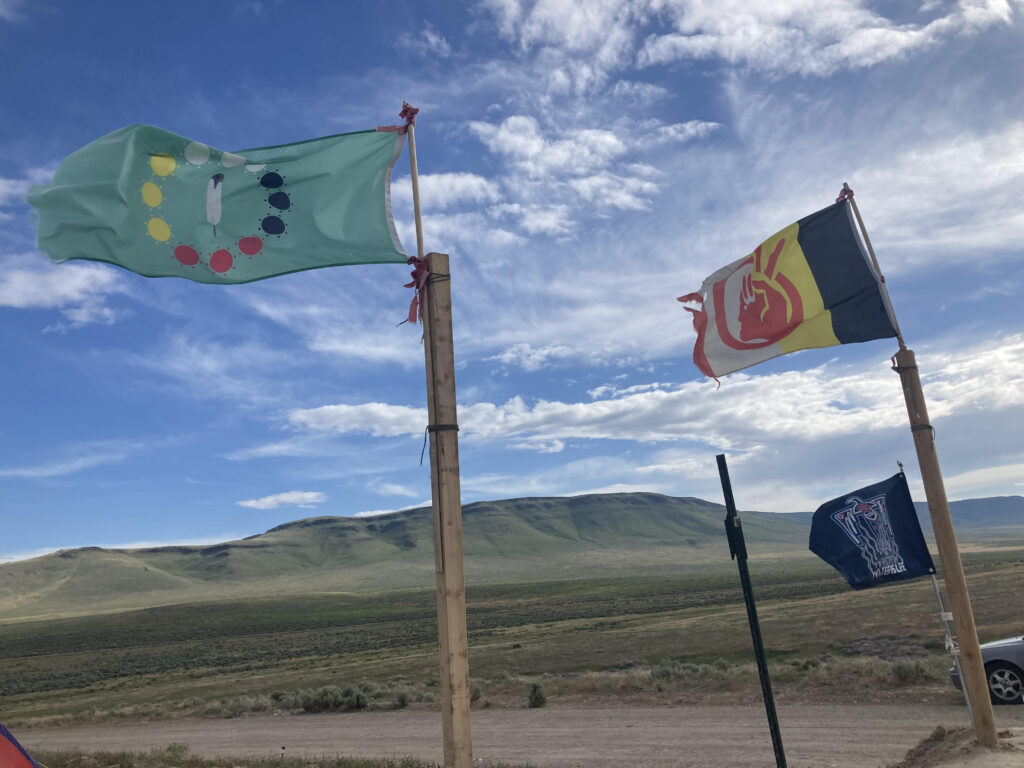
The first resisters at Thacker Pass were not Native Americans. They were two white men, Max Wilbert and Will Falk, who set up tents at the proposed site in January of 2021, following the Trump administration’s final approval of the Lithium Americas project. Falk, an environmental attorney, joined as co-occupier and legal adviser to Wilbert, who had spent the previous two years working on a book about the dark side of renewable energy technologies. Both were in their 30s, both were hungry to make a difference on the ground in Nevada.
The book, “Bright Green Lies,” published in 2021 and co-authored with activists Derrick Jensen and Lierre Keith, is a compendium of horrors caused by the mining complexes that make possible wind and solar plants, green batteries and electric vehicles. The destruction from green-tech mining is no secret; one needs only to have eyes to look for it. Key to the manufacture of electric vehicles and wind turbines, for example, are rare earths such as neodymium and dyspromium, which are largely derived from an open-pit mine a half-mile deep near the Chinese city of Baotou, in Inner Mongolia. The factories that apply sulfates, ammonia and hydrochloric acid to refine the rare earths release 2,000 tons of toxic waste for every ton of product. The waste is gathered in a vast tailings pond outside Baotou, three square miles large, in which no life survives because the “water” is radioactive. The shore is a black crust so thick one can walk on it.
“Before the factories were built,” a Mongolian farmer named Li Guirong told The Guardian, “there were just fields here as far as the eye can see….there were watermelons, aubergines and tomatoes.” With decades of rare earth mining came toxification of soil and groundwater, which over time killed all his livestock – pigs, cows, horses, chickens and goats – until at last Li was forced to abandon the farm. According to Wilbert, many of the local residents have been like Li. They have fled or been forcibly relocated. Those who remain have suffered a host of diseases.
Across the globe, the industry has been implicated in the poisoning of water and air, the sickening of towns and villages, and the depopulation of whole regions due to water scarcity.
The environmental record of lithium mining is similarly bleak. Across the globe, the industry has been implicated in the poisoning of water and air, the sickening of towns and villages, and the depopulation of whole regions due to water scarcity. Lithium mining is water intensive, often causing water tables to diminish or water quality to collapse.
On the Tibetan Plateau, the Ganzizhou Rongda lithium mine operates along the Liqi River, where native inhabitants have fished and herded for thousands of years. God is in the mountains and the rivers, say the Tibetans who live by the Liqi, because these are the rich places that nourish the spirits of the natural world. “Their land, their animals, and their existence are being destroyed by lithium mines,” Wilbert and his co-authors write in “Bright Green Lies.” “The Liqi River was once full of fish: Almost none are left.” The destruction of the fish has been due to chemical spills from the Ganzizhou mine. “‘The whole river stank, and it was full of dead yaks and dead fish,’ said one villager… One of the elders said, ‘Old people, we see the mines and we cry. What are the future generations going to do? How are they going to survive?’”
With such testimonials in mind, Wilbert and Falk set their tents. They called their camp Protect Thacker Pass. It was just the two of them at first. “Environmentalists might be confused about why we want to interfere with the production of electric car batteries,” said Falk in a press release issued the week they took their stand. “It’s wrong to destroy a mountain for any reason.”
The two men endured much misery during the winter and spring of 2021: blizzards, gales, freezing nights, spring floods, mires of mud six inches deep. Their tents shredded in 50-mile-per-hour winds. They ate frozen carrots and shivered in their sleeping bags. Other resisters joined them as the weather warmed. The camp grew in size, numbering at one point more than two dozen people, who soon experienced the joys of summer in the steppe, with its blazing heat and oppressive sun and the violence of its dust storms. There was dust in their eyes, their food, their water, black widows by their bedsides, rattlesnakes at their bootheels. An atmospheric river burst above northwestern Nevada early in the autumn of 2021, flooding the camp, toppling tents yet again. A ceremonial fire tended by the Paiutes somehow stayed lit.
When I camped with Wilbert in November 2021, we walked together the old growth sagebrush and high desert bunchgrasses. The nights were cool, the days balmy, the place filled with a feeling of peaceful majesty. Wilbert was 33 at the time, but he looked much younger. He was a hunter of deer, and he had the small wiry frame and sharp clear eyes of someone who spends a lot of time on foot in the rough terrain of the backcountry. We climbed to a ridge above Thacker Pass at the southern rim of a range of rolling sagebrush uplands called the Montana Mountains. The ridge afforded a sweeping view of immensity. No machines stirred for miles around. The one paved road that crossed the valley might as well have been a footpath.
Wilbert shared with me a nightmare vision of the mine’s operations as proposed in its scoping documents. Miles and miles of new roads would fragment the valley. Trucks would move across the new roads in numbers the valley had never seen. The open pit for the digging out of the lithium would be as deep as a football field and more than two miles wide. There would be a liquid molten sulfur plant to boil down the lithium, fed by scores of trucks every day carrying the molten material from distant rail depots, along with soda ash and quicklime. The processing plants would release sulfur compounds and other pollutants into the air. The mine as a whole would burn through 11,000 gallons of diesel per day, with more than 200 tractor trailer loads entering and leaving every 24 hours. It would blight the night sky with glaring lights and shatter the silence of the desert with grinding noise. In the driest state in the country it would draw from local aquifers some 4 million gallons of water a day, via a new pipeline stretching scores of miles. (The average Nevada resident uses 134 gallons a day.) There was a chance, too, the mine would permanently poison groundwater in the valley with radioactive compounds.
Environmental activists who are critical of the green-tech mining expansion in the American West claim that one of the keys to its success is regulatory failure.
The usual disagreement arose between the scientists hired by Lithium Americas to assess the project’s impact and those who had independently reviewed the likelihood of environmental catastrophe. Among the many contentious subjects was the design of the tailings stack, where the toxic sludge from the mine was to be piled in a small mountain several hundred feet high. Steve Emerman, an environmental consultant who specializes in hydrology, submitted a report to the U.S. Bureau of Land Management, which has oversight of the project because it takes place on public land, that warned the tailings stack could not be constructed as designed “because it would collapse.” The BLM ignored him, as did the Nevada Department of Environmental Protection, which issued Lithium Americas its requested permit for the stack. “What happens if the tailings stack collapses? Nobody knows because nobody has studied this question,” Emerman told me. “Where will the tailings go? What will be the impacts on surface water, groundwater, vegetation, wildlife, livestock, ranchers? Nobody knows.” Emerman pointed to the Nevada Department of Environmental Protection as an unethical actor. “They have granted a permit without a workable plan for tailings safety. Therefore, the plan will be developed (if it is developed) by the mining company alone without any governmental oversight,” he told me. “That is a serious abdication of responsibility.”
Environmental activists who are critical of the green-tech mining expansion in the American West claim that one of the keys to its success is regulatory failure. “The pressure is really on to permit these mine sites in a fast-tracking process that ignores or pays lip-service to regulatory processes and community concerns,” John Hadder, executive director of Great Basin Resource Watch, told me. “The rush for so-called green extraction, bypassing environmental review, looks more and more like the old, dirty gold rush.”
Katie Fite wrote me an email with her assessment of the project as a wildlife biologist. The mine’s “medusa-headed disturbance footprint will be calamitous for a huge swath of beautiful wild country and its animal inhabitants.” The Montana Mountains, said Fite, stretch into the Trout Creek and Oregon Canyon Mountains in Oregon, constituting an enormous block of undeveloped sagebrush wildlife habitat. The “mega-mine” at Thacker, as she called it, would “destroy utterly” the last lower-elevation sagebrush winter habitat that remains for many species.
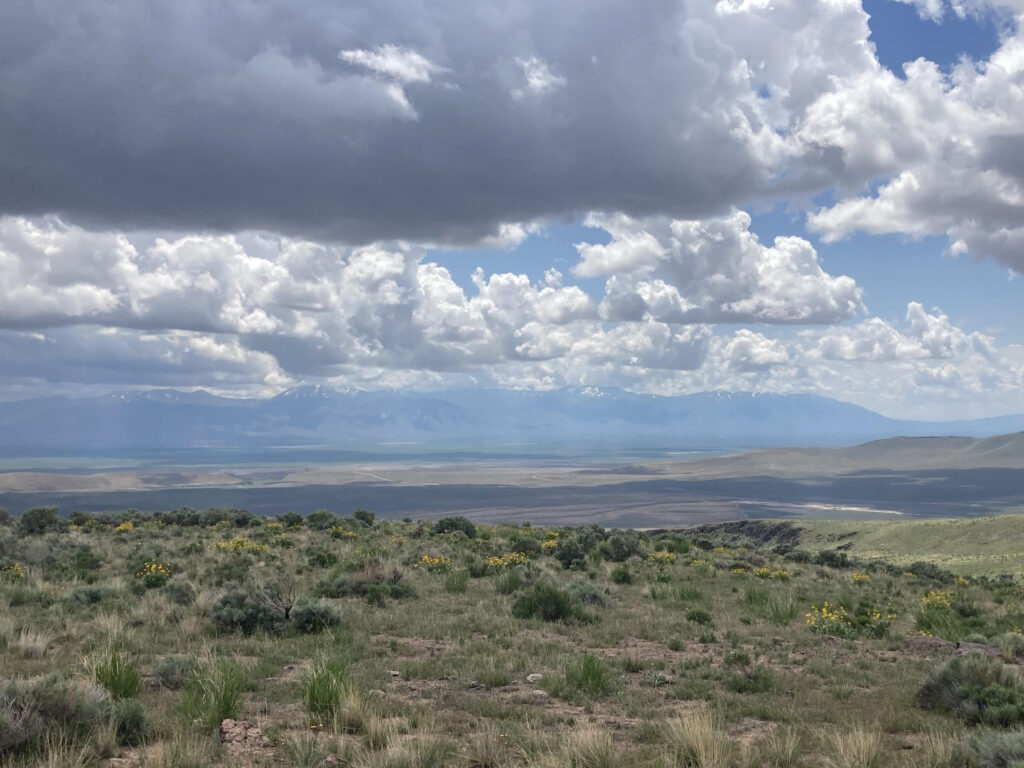
When Wilbert and I arrived at the height of the ridge in the Montana Mountains, I asked him whether the sacrifice of Thacker Pass was necessary for the greater good of maintaining industrial civilization. The valley lay below us, splendid in afternoon light, and it seemed a loaded question. Of course, you don’t want to destroy this place – but destroy it and potentially we could enable millions of Americans to drive cars freed from dependence on fossil fuels. “To people who say this is a necessary sacrifice, I say quite simply that they’re lying,” Wilbert told me. “It’s not necessary. No more than fossil-fuel-powered cars and the whole culture that’s been built around cars is necessary. It’s one choice, one model of economic development. And it may seem normal, it may seem like the way things are, but it doesn’t mean that has to be the way things are. I think we need to change the way we live.”
That night was the 170th he had slept in a tent at Thacker Pass. The moon was a bright waxing crescent that lit the rippled clouds. In the vastness of the moon-washed dark I pressed him about the quixotic nature of his protest. People will always drive cars, I suggested. I got to Thacker Pass by car. So did he. Why not make them carbon-free? “Will we always drive cars? You can only buy the logic that electric cars are going to help us if you believe that we need cars at all. Our ancestors didn’t have cars. It’s an uncomfortable thought that things may have to be completely different in the future.”
With such directness, Wilbert and Falk had stirred an uprising of fellow dissenters that painted Lithium Americas, which was supposed to be the good guy in the climate crisis, as just another extractivist profiteer. Conservation nonprofits filed lawsuits in federal court in an attempt to quash the project. A local rancher charged that the mine would drain the aquifers on which his livestock business depended. Tribes filed suit to prove the valley was holy and historically significant, alleging the Bureau of Land Management had failed to consult with them prior to approving it for development. Together, this broad coalition – of radicals, environmentalists, Native Americans, a rancher and his community backers – succeeded in halting Lithium Americas’ progress for almost two years.
Together, this broad coalition – of radicals, environmentalists, Native Americans, a rancher and his community backers – succeeded in halting Lithium Americas’ progress for almost two years.
The Indians hoped to draw a critical mass of protesters similar to the thousands-strong encampment at Standing Rock in South Dakota in 2016. The Sioux had led that fight – a fruitless one, against an oil pipeline that ultimately was built – and some of the veterans of the siege at Standing Rock now leant their weight to the resistance at Thacker Pass. But it was to no avail. Wilbert and Falk’s camp was forced to disband. The courts batted away all challenges to the mine. In the spring of 2023, the company got the word from U.S. Judge Miranda Du, presiding in the District of Nevada, that no further legal obstacles lay in its path. It was time to break ground and start the process of moving the lithium to market.
That’s when the Grandmas headed into the fray with what force they could muster. They were led by a Paiute elder named Josephine Sam and her niece, Dorece Sam, who chose for the site of their protest camp a place where they believed that prayers for their ancestors would be best heard. It happened that the site for their prayers was also smack in the middle of the water pipeline, which Lithium Americas said was pivotal to the operation of the mine.
Josephine and the other Grandmas christened the camp, in their native tongue, Ox Sam Newe Momokonee Nokutun, or the Ox Sam Indigenous Women’s Camp. It was named for one of the three survivors of the 1865 massacre of Paiutes by U.S. soldiers at the site, a man named Ox Sam, Josephine Sam’s great-grandfather. Soon the Grandmas were making trouble for Lithium Americas, despite their small numbers.
The company did what was smartest to do, refusing to confront head-on the restless natives, as this would be bad publicity. During the spring and into the early summer, the Indians encamped at Thacker Pass blockaded one of the major access roads to the mine site, turned away the machines and stymied the dig. On the single road they shut down, not an excavator, bulldozer, tractor trailer or bus full of hard-hatted workers was allowed to pass. (Lithium Americas was able to redirect traffic to another road, which the resisters hadn’t enough numbers to blockade, and continue building out other parts of the mine.)
A lawsuit filed in May in Nevada civil court by Lithium Americas’ subsidiary, Lithium Nevada, described this activity as a “conspiracy” and named as defendants Dorece Sam, Max Wilbert, Will Falk, the group Protect Thacker Pass and several other indigenous resisters whose identities the company said it would reveal with further investigation. The lawsuit demanded that the defendants be held liable for possibly millions of dollars in damages to the company’s operations and its reputation.
For their part, the defendants considered the suit a form of harassment that would oppressively burden them with lawyers’ fees and effectively chase them off the public land that Lithium Americas had leased for its project. Such strategic lawsuits against public participation, or SLAPP suits, are intended to silence free speech and protest, and they have been dangerously effective. “Corporations strike back against those who seek to defend the land,” Wilbert wrote in a July email to supporters. “My friends in the Philippines, Colombia, Mexico, and many other countries face torture and death for simply speaking out in favor of protecting land and water.” Instead, he said, corporations in the U.S. resort to the tactic of crushing red-skinned land defenders with the nastiness of spurious lawsuits.
The company’s aggressive behavior has extended to random citizens on public lands. When biologist Fite arrived at the remnants of the Indigenous Women’s Camp in June, a day after it was raided, she sought access to the sagebrush near the mine site to conduct a plant and animal survey. The sky was full of doomy clouds and there were rumblings of distant thunder. She found her way barred by a guard for a private security company that Lithium Americas had hired. The company, Allied Security, blocked the road — a public access road, on public land — with a truck parked across it and a newly-stretched chain link fence festooned with no trespassing signs.
She approached the Allied Security guard, who refused to let her pass. Fite protested. The guard called his boss, who arrived in a white pickup truck as a whirlwind of sudden rain bore down and the wind howled. The boss’s face was obscured in a balaclava-like hood and dark sunglasses. He pointed a hand-held camera at Fite. “I thought WTF is this — a security firm mercenary decked out for Operation Iraqi Freedom and Abu Ghraib?” she wrote on Facebook. “The Allied Security ‘boss’ retreated to his pickup as the rain splattered its windows – likely running me and my license plates through some creepy database. Finally, he let me pass.”
She had repeated again and again this was public land. “So this is how it’s going to be with the green corporations,” Fite told me when I asked her about her encounter at Thacker Pass. “Same old shit.”

In the last week of May, not long before the raid that ended it, I visited the Indigenous Women’s Camp. I had no tent but was offered one, along with a sleeping bag and a sleeping pad, and gladly took up residence for a few nights. A 43-year-old Yaqui man named Wolf, lithe and wary, was running the place. He was a self-described warrior, member of the American Indian Movement, which was said to be radical. He had traveled from his home in Los Angeles to support his fellow Indians, and now he blessed me in his native Nahuatl as we sat before the fire in the teepee.
His nephew, Young Blood, also from Los Angeles, cleaned the kitchen and canteen, which consisted of folding tables and chairs under a tarp stretched on tall poles to provide shade and keep off the rain. Young Blood was thin and taciturn, with a brass nose-ring and a tattooed chin. He was a rapper, and one evening he “spat” his lyrics as I laid a beat with my fingers on a table that served as a resonating drum. Young Blood said he would put his own life before that of the life of the land at Thacker Pass. He was a young man full of vigor, in his 20s, and very serious.
The camp sat directly in the way of the pipeline, and the pipes themselves lay in useless piles, the company unable to fit them together and sink them in the earth, because the protesters refused to move.
The site he was helping to hold was the same the Grandmas had chosen, an industrial scar for a water pipeline corridor Lithium America had bulldozed weeks earlier. The sagebrush had been torn out and only bare soil remained, the corridor running for many miles across Thacker Pass into the valley of the Quinn River, where the aquifer would be tapped to feed the mine’s thirst of five million gallons a day. The camp sat directly in the way of the pipeline, and the pipes themselves lay in useless piles, the company unable to fit them together and sink them in the earth, because the protesters refused to move. Without the pipeline, there was no mine, no lithium to be dug out, and no money to be made.
A handsome 12-year-old boy named Young Native – they all had code names, none daring to share their actual identities – told me his father had been at Standing Rock and had fought there against the oil pipeline. All pipelines, said Young Native, were basically the same. “My dad said that everyone at Standing Rock got hit with tear gas, rubber bullets, water cannons and clubs. We had cedar burning, sage and teepees, and we had the people. But they still built that pipeline.” I asked him why he had come to Thacker Pass. “I’m here to fight the pipeline!” I walked with Young Native along the scar of the pipeline corridor, where the pipes were piled, and into the pipes Young Native shouted funny sounds. The echoes in the pipe segments were entertainingly warped and eerie. “It sounds like Star Wars,” he said. I did my best Darth Vader impression and beckoned Young Native to the dark side. He crossed his arms and lorded over the scene, bandana over his face, and put a boot on one of the pipes. He looked like a bandit for the ages.
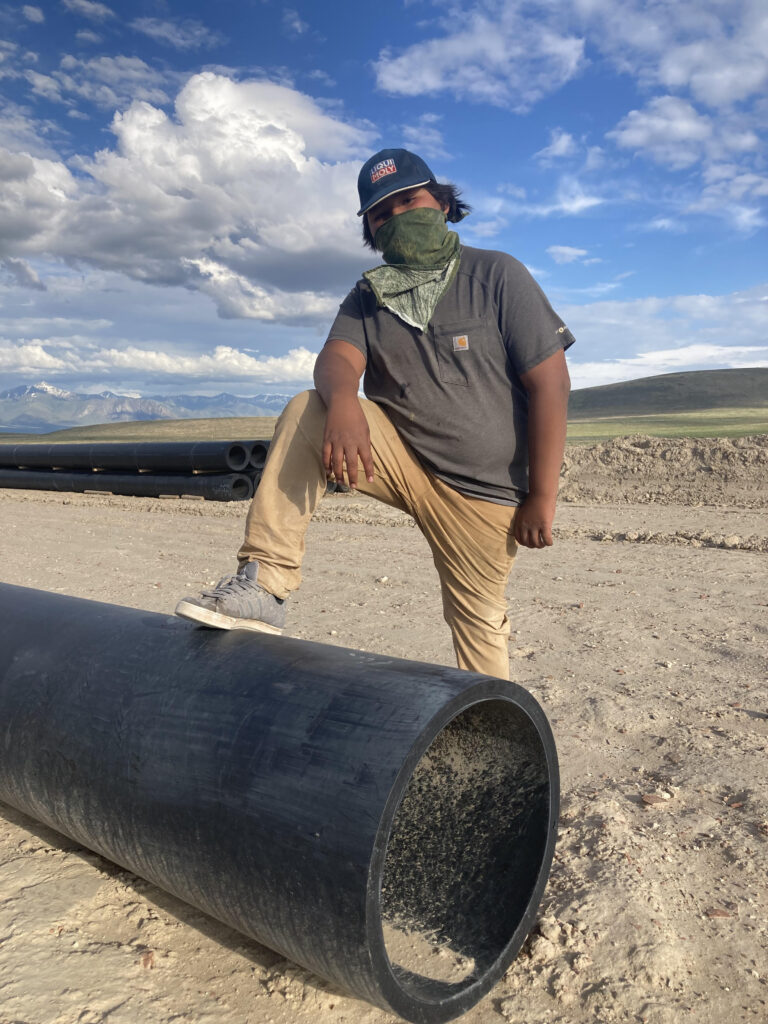
Most of the time at the camp was spent talking and listening. Wolf told me the history of the American Indian Movement, and about one of his favorite Indian writers, John Trudell, the finest of the AIM activists and spokesmen. Tragic sorrow had befallen Trudell to make him a poet. On Feb. 11, 1979, Trudell burned an American flag on the steps of the FBI building in Washington, D.C. The burning of the flag was a symbolic protest of the centuries of ill treatment of Indians by federal authorities. Within 24 hours, Trudell’s home at the Duck Valley Indian Reservation (as it happens, a hundred miles to the northeast of Thacker Pass) burst into flames. His wife, mother-in-law and three children were inside. They burned alive. Authorities said it was an accident, but most Indians didn’t believe it. Wolf didn’t believe it. “They killed his whole family,” said Wolf, “because he burned a flag.”
One morning I was awakened by a recording of one of Trudell’s poems, his sonorous voice booming on a loudspeaker:
We see your technological society devour you before your very eyes.
We hear your anguished cries exalting greed through progress.
While you seek material advances,
the sound of flowers dying,
carry messages through the wind,
trying to tell you about balance and your safety.
But your minds are chained to your machines…
There were many such mornings of poetry and song at the camp. One night at dusk, Wolf emerged from his tent with a drum and mallet and sang to the setting sun. He told me it was a holy chant, one of respect and love. But it could not last. A day after I left, Young Blood stopped in its tracks an excavator along the pipeline corridor. Wolf was busy as well, planting his 107-pound body before a 45,000-pound D6T bulldozer. This was at last too much for both Lithium Americas and local authorities. On the day of the raid, Wolf was gone to see his son in Los Angeles, and there was only one person at camp, a teen-aged girl named Mystics. She was arrested and taken away and the camp was destroyed in short order.
Young Blood and others fled into the backcountry. We know this because they documented it. They shot video of themselves carrying backpacks and breathing heavily as they climbed high over the valley through outcrops of volcanic rock. It reminded me of the frames of an old western movie I had seen once, with Indians scattered in the hills, fleeing the march of the white man’s progress.
Your support matters…Independent journalism is under threat and overshadowed by heavily funded mainstream media.
You can help level the playing field. Become a member.
Your tax-deductible contribution keeps us digging beneath the headlines to give you thought-provoking, investigative reporting and analysis that unearths what's really happening- without compromise.
Give today to support our courageous, independent journalists.
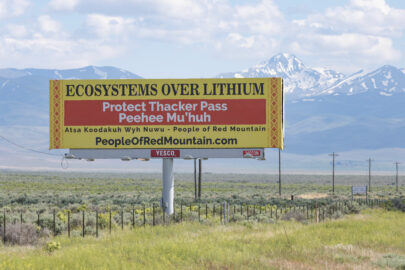






You need to be a supporter to comment.
There are currently no responses to this article.
Be the first to respond.